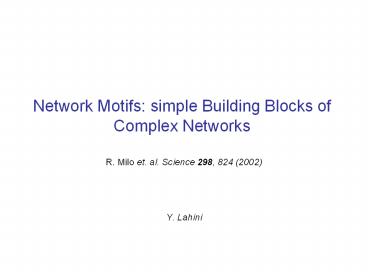Network Motifs: simple Building Blocks of Complex Networks - PowerPoint PPT Presentation
Title:
Network Motifs: simple Building Blocks of Complex Networks
Description:
Network Motifs: simple Building Blocks of Complex Networks R. Milo et. al. Science 298, 824 (2002) Y. Lahini Internet as measured by Hal Burch and Bill Cheswick's ... – PowerPoint PPT presentation
Number of Views:136
Avg rating:3.0/5.0
Title: Network Motifs: simple Building Blocks of Complex Networks
1
Network Motifs simple Building Blocks of Complex
Networks
- R. Milo et. al. Science 298, 824 (2002)
- Y. Lahini
2
The cell and the environment
- Cells need to react to their environment
- Reaction is by synthesizing task-specific
proteins, on demand. - The solution regulated transcription network
- E. Coli 1000 protein types at any given moment
gt4000 genes (or possible protein types) need
regulatory mechanism to select the active set - We are interested in the design principles of
this network
3
Proteins are encoded by DNA
translation
transcription
4
Gene Regulation
- Proteins are encoded by the DNA of the organism.
- Proteins regulate expression of other proteins
by interacting with the DNA
Transcription factor
external signal
DNA
Coding region
promoter region ACCGTTGCAT
5
Two types of Transcription Factors 1.Activators
X
No transcription
X
Y
gene Y
X binding site
Y
Y
Sub-second
Y
Y
Sx
Seconds
X
X
INCREASED TRANSCRIPTION
X
Hours
Bound activator
Separation of time scales TF activation level is
in steady state
6
Two types of Transcription Factors Repressors
X
Y
Y
Y
Unbound repressor
Y
Y
X
Bound repressor
Sx
X
X
No transcription
X
Bound repressor
7
Equations of gene regulation
- If X regulates Y, the net production rate of
gene Y is - a- Dilution/degradation rate
- K activation coefficient concentration
related to the affinity - ß maximal expression level
- Step approximation gene is on (rate ß) or off
(rate 0) with threshold K
8
The gene regulatory network of E. coli
- Nodes are proteins (or the genes that encode
them) - Edges regulatory relation between two proteins
9
Analyzing networks
- Find n-node subgraphs in real graph.
- Find all n-node subgraphs in a set of randomized
graphs with the same distribution of incoming and
outgoing arrows. (Newman, 2000, Sneppen, Malsov
2002) - Assign Z-score for each subgraph.
- Subgraphs with high Z-scores are denoted as
Network Motifs.
10
Analyzing networks
- The idea- patterns that occur in the real network
much more then in a randomized network, must have
functional significance. - The randomized networks share the same number of
edges and number of nodes, but edges are assigned
at random
11
The known E. Coli transcription network
12
A random graph based on the same node statistics
13
3-node network motif the feedforward loop
Nreal40 Nrand73
14
The feedforward loop a sign sensitive filter
The feedforward loop is a filter for transient
signals while allowing fast shutdown
Mangan, Alon, PNAS, JMB, 2003
15
The Feedforward loop a sign sensitive filter
Vs.
lacZYA
araBAD
Mangan, Alon, PNAS, JMB, 2003
16
Single Input Module
- Temporal and expression level program
generator - The temporal order is encoded in a hierarchy of
thresholds - Expression levels hierarchy is encoded in
hierarchy of promoter activities
17
Single Input Module motif is responsible for
exact timing in the flagella assembly
18
Single Input Module motif is responsible for
exact timing in the flagella assembly
Kalir et. al., science,2001
19
Single Input Module turns on the SOS response in
E. coli
20
The gene regulatory network of E. coli
Single input modules Feed-forward loops
- Shallow network, few long cascades.
- Modular
Shen-Orr et. al. Nature Genetics 2002
21
Evolution of transcription networks
- In 1 day, 1010 copies of e-coli, 1010 replication
of DNA. - Mutation rate is 10-9
- 10 mutations per letter in the population per day
- Even single DNA base change in the promoter can
change the activation/repression rate - Edges can be lost or gained (i.e. selected)
easily.
22
Links between WebPages a completely different
set of motifs is found
- WebPages are nodes and Links are directed edges
- 3 node results
23
Structure of a nematode neuronal circuitry
Head Sensory
Ventral Cord Motor
Ring Motor
White, Brenner 1986 Durbin, Thesis, 1987
24
Neurons and transcription share similar motifs
C. elegans
25
(No Transcript)
26
(No Transcript)
27
Summary
- The production of proteins in cells is regulated
using a complex regulation network - Network motifs simple building blocks of complex
networks - An algorithm to identify network motifs
- Example the transcription network of E. coli.
- The feed forward loop as a sign sensitive filter
- The single input module exact temporal ordering
of protein expression
28
Thanks
29
Equations of gene regulation
- If X regulates Y, the net production rate of
gene Y is - a- Dilution/degradation rate
- K activation coefficient concentration
related to the affinity - ? maximal expression level
- n the Hill parameter (steepness of the
response, usually 1-4) - Step approximation gene is on (rate ß) or off
(rate 0) with threshold K
30
Actors web
31
Mathematicians Computer Scientists
32
Sexual contacts M. E. J. Newman, The structure
and function of complex networks, SIAM Review 45,
167-256 (2003).
33
High school dating Data drawn from Peter S.
Bearman, James Moody, and Katherine Stovel
visualized by Mark Newman
34
Internet as measured by Hal Burch and Bill
Cheswick's Internet Mapping Project.
35
Metabolic networks
KEGG database http//www.genome.ad.jp/kegg/kegg2.
html
36
Transcription regulatory networks
Single-celled eukaryote S. cerevisiae
Bacterium E. coli
37
C. elegans neuronal net
38
Dense Overlapping Regulons (DOR)
Bi-fan
Nreal 203 Nrand 4712 Z Score 13
Array of gates for hard-wired decision making
Buchler, Gerland, Hwa, PNAS 2003 Setty, Mayo,
Surette, Alon, PNAS 2003































